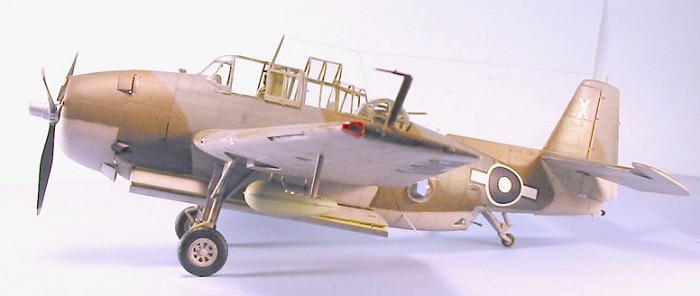
Trumpeter 1/32 TBF-1C Avenger
| KIT #: | 02233 |
| PRICE: | $129.95 MSRP |
| DECALS: | Two options |
| REVIEWER: | Tom Cleaver |
| NOTES: | The most complicated and complex model I’ve built in a long time - but that doesn’t mean it’s difficult |

| HISTORY |
Grumman’s TBF Avenger is the most successful naval strike aircraft ever built. The airplane was equally at home on fleet aircraft carriers, small escort carriers, and forward air bases, providing outstanding performance in torpedo strike, bombing, anti-submarine, and close air support roles. Easy to fly for a wartime-trained pilot, it was reliable and rugged and trusted by those who flew in it.
The Douglas TBD Devastator was the most modern carrier-based airplane in the world when it appeared in 1937. Such was the pace of aviation development that, a mere two years later it was seen as being in need of a more capable replacement. Purchased with peacetime funds, the 130 TBDs were completely inadequate for the needs of a world-wide naval war. Indeed, by June 6, 1942, there were only some 30 TBDs left in flyable condition and the airplane had thoroughly demonstrated its inability to survive in a modern air combat environment.
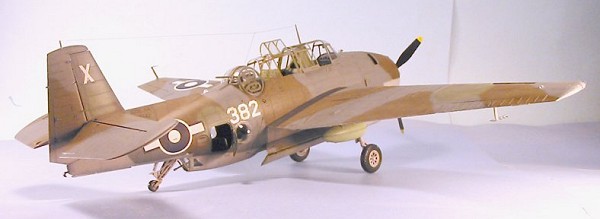 Fortunately, the Navy’s Bureau of Aeronautics had issued a requirement for
a new torpedo/level bomber in 1939. This was answered by Chance Vought
with an airplane designated the TBU-1, and by Grumman with the TBF-1. Both
aircraft were roughly similar, though the Grumman design was smaller - an
important point for a carrier-based airplane where deck space is at a
premium - and faster. The Vought aircraft was delayed by that company’s
commitment to designing and developing the F4U Corsair, and would later by
produced in limited numbers by Consolidated as the TBY-1 “Seawolf;” it
would not see combat.
Fortunately, the Navy’s Bureau of Aeronautics had issued a requirement for
a new torpedo/level bomber in 1939. This was answered by Chance Vought
with an airplane designated the TBU-1, and by Grumman with the TBF-1. Both
aircraft were roughly similar, though the Grumman design was smaller - an
important point for a carrier-based airplane where deck space is at a
premium - and faster. The Vought aircraft was delayed by that company’s
commitment to designing and developing the F4U Corsair, and would later by
produced in limited numbers by Consolidated as the TBY-1 “Seawolf;” it
would not see combat.
Grumman’s design included a power-operated rear turret of incredibly-simple design, and an internal bomb bay capable of carrying 2,000 lbs of ordnance, including general purpose or armor-piercing bombs, or a Mk. XIII torpedo. Operated by a crew of three, it had power-operated folding wings that could reduce its 54-foot span to 18 feet, thus allowing it to be operated from all Navy aircraft carriers. The original specification had called for a top speed of 320 m.p.h., which was revealed as only 274 mph when the first prototype flew in August 1941. Test flights revealed only a need for an extended fin for directional stability, everything else in the design performing as expected.
The first prototype was lost accidentally on November 29, 1941, when pilot Hobart Clark and engineer Gordon Israel mistook a fine mist of hydraulic fluid from a broken line for smoke that indicated an onboard fire, and bailed out ten miles from Grumman’s field at Bethpage. Fortunately, a second prototype had already been ordered, and was delivered on December 15, 1941, by which time the airplane had gone from Very Important to Absolutely Crucial in the Navy’s planning. In January 1942, the torpedo bomber was given the name “Avenger” - for obvious emotional reasons - a name it would more than live up to over the next three years.
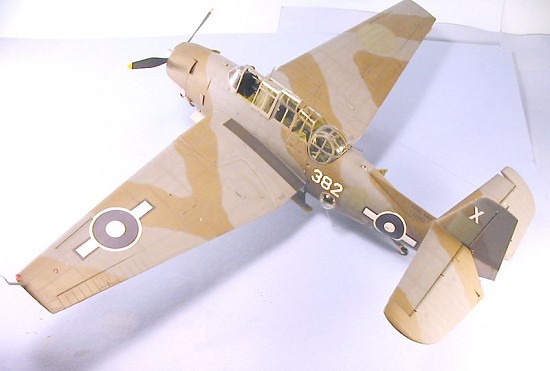 Production started quickly and the first squadron - VT-8, aboard the
“Hornet” - began receiving aircraft in April. Unfortunately, there was not
enough time for the squadron to fully convert to the new airplane before
the ship was ordered to the Pacific, where Torpedo Eight would fly into
immortality in their lumbering TBDs on June 4, 1942 at Midway.
Production started quickly and the first squadron - VT-8, aboard the
“Hornet” - began receiving aircraft in April. Unfortunately, there was not
enough time for the squadron to fully convert to the new airplane before
the ship was ordered to the Pacific, where Torpedo Eight would fly into
immortality in their lumbering TBDs on June 4, 1942 at Midway.
By the Battle of Midway, Grumman was producing 60 TBF-1s a month, and production exceeded 100aircraft per month in November. By the end of 1942, Grumman had delivered 646 Avengers, and would attain a production rate of 150 per month through 1943. This wasn’t enough, and with the company’s prime commitment being the development and full-scale production of the even-more-desperately-needed F6F Hellcat, it was decided to bring in a second company to produce the Avenger. The General Motors in New Jersey was turned over to a new subsidiary known as Eastern Aircraft for this purpose. Those in the aviation industry were doubtful of the automotive industry’s ability to engage in mass production to the far-more-demanding tolerances of aircraft, but GM proved that - with the assistance of Grumman in simplifying assembly of the Avenger - they were capable of meeting the challenge. Production began in November 1942 with the assembly of Grumman-built TBFs, and by May 1943 had hit 100 aircraft - known as the TBM Avenger - a month. Of the 9,837 Avengers built during the war, Eastern Aircraft would produce 7,546 of them, including all of the more advanced TBM-3 version.
The Avenger proved itself during the Battle of Guadalcanal, where the airplanes of several displaced carrier air groups sank the damaged Japanese battleship Hiei after the Naval Battle of Guadalcanal on November 14, 1942, and then sank six of the nine Japanese transports headed down “The Slot” in the major Japanese attempt to re-take the vital island. That these were accomplished with the then-unreliable Mk. XIII torpedo - which required the airplane to fly no faster than 120 mph at a height of no more than 100 feet - made the achievement all the more remarkable. When Navy Secretary James Forrestal later said that “Grumman saved Guadalcanal,” he was referring to the Wildcat, but the Avenger was more than worthy of inclusion in the praise.
The Avenger went on to become the backbone of the Navy’s anti-U-boat campaign in the Atlantic, and - finally equipped in 1944 with the “ring-tail” Mk. XIII that allowed high-speed, higher-altitude torpedo strikes with weapon accuracy -Avengers sank the two biggest battleships ever built: the Musashi in October 1944 and her sister Yamato in May 1945.
The Fleet Air Arm and the Avenger:
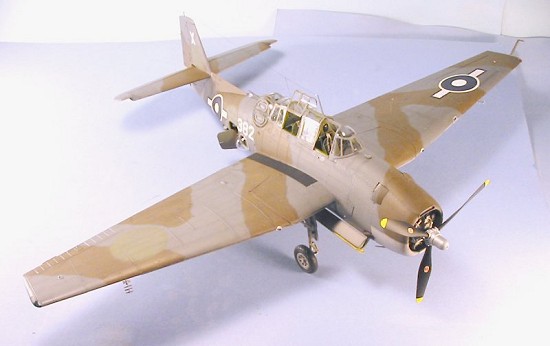 Britain’s Fleet Air Arm was never able to produce aircraft as robust and
with such high performance as the US Navy’s aircraft during the Second
World War. Thus, when the Avenger became available for British use through
Lend-Lease, their Lordships at the Admiralty were quick to become the
second-largest operator of the Avenger during the war, using 1,000 of them.
Initially known as the Tarpon for the large Atlantic fish, the FAA
standardized on American names in January 1944, with the Tarpons becoming
Avengers. 402 Grumman-built TBF-1Bs (which were equivalent to both the
TBF-1 and the TBF-1C without further differentiation) were known as the
Tarpon/Avenger I, while 334 TBM-1Cs were known as Tarpon/Avenger II, and
222 TBM-3s as Avenger IIIs. The British differentiated their Avengers by
production source, having discovered that the same aircraft built by
different manufacturers was not really the “same aircraft.” Unlike the
U.S. Navy, which re-equipped its units with ever-newer versions of the
Avenger, the British used all of their Avengers throughout the war, with
both Avenger Is and Avenger IIs being flown by the same squadron,
distinguishable only by their different-colored camouflage schemes
(Grumman-built Avenger Is used the correct FAA-approved camouflage colors,
while the Eastern Aircraft-built Avenger IIs were in US “equivalent
colors”).
Britain’s Fleet Air Arm was never able to produce aircraft as robust and
with such high performance as the US Navy’s aircraft during the Second
World War. Thus, when the Avenger became available for British use through
Lend-Lease, their Lordships at the Admiralty were quick to become the
second-largest operator of the Avenger during the war, using 1,000 of them.
Initially known as the Tarpon for the large Atlantic fish, the FAA
standardized on American names in January 1944, with the Tarpons becoming
Avengers. 402 Grumman-built TBF-1Bs (which were equivalent to both the
TBF-1 and the TBF-1C without further differentiation) were known as the
Tarpon/Avenger I, while 334 TBM-1Cs were known as Tarpon/Avenger II, and
222 TBM-3s as Avenger IIIs. The British differentiated their Avengers by
production source, having discovered that the same aircraft built by
different manufacturers was not really the “same aircraft.” Unlike the
U.S. Navy, which re-equipped its units with ever-newer versions of the
Avenger, the British used all of their Avengers throughout the war, with
both Avenger Is and Avenger IIs being flown by the same squadron,
distinguishable only by their different-colored camouflage schemes
(Grumman-built Avenger Is used the correct FAA-approved camouflage colors,
while the Eastern Aircraft-built Avenger IIs were in US “equivalent
colors”).
Originally, British Tarpons were expected to have 4-man crews: pilot, observer/navigator, radioman and gunner/bombardier, but it was later decided to use a three-man crew in the US manner, though the British Avengers used the second cockpit as an observation site, unlike the US Navy.
British Avengers first went into action in the Atlantic with a few squadrons operating in the anti-submarine role aboard escort carriers. However, the major use of the Avenger by the British was aboard their fleet carriers. In the Atlantic, Avengers took part in the strikes against the “Tirpitz” in Norway, and other anti-shipping strikes in Norwegian waters, and provided air support to the Normandy Invasion, flying patrols against U-boats and possible S-boat attacks against the invasion fleet.
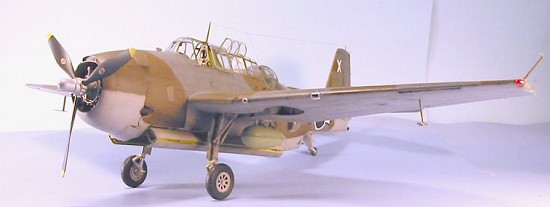 Major British use of the Avenger was in the Indian Ocean and the Pacific in
1944-45. The most successful Royal Navy operation involving the Avenger was
“Operation Meridian,” a two-phase attack against the Sumatran oil fields in
the Netherlands East Indies in January 1945. Four fleet carriers -
Indomitable, Illustrious, Indefatigable and
Victorious -
operated 4 Avenger squadrons for a total of 65 Avengers. The first strike
against Pladjoe on January 24, 1945, involved 47 Avengers which gave
sterling service with their accurate bombing, which destroyed30 percent of
the production facilities. The second strike on January 29 - which was
carried out in the teeth of much stronger Japanese aerial opposition -
resulted in a drop of 65% of aviation gasoline production at a time when
the Japanese could ill-afford such a loss. Nine Avengers were lost in the
first strike, mostly to flak, while 11 were lost to flak and fighters on
the second mission. The Avenger proved a tough nut for Japanese fighters
with eight shot down, two by pilots using their forward armament.
Major British use of the Avenger was in the Indian Ocean and the Pacific in
1944-45. The most successful Royal Navy operation involving the Avenger was
“Operation Meridian,” a two-phase attack against the Sumatran oil fields in
the Netherlands East Indies in January 1945. Four fleet carriers -
Indomitable, Illustrious, Indefatigable and
Victorious -
operated 4 Avenger squadrons for a total of 65 Avengers. The first strike
against Pladjoe on January 24, 1945, involved 47 Avengers which gave
sterling service with their accurate bombing, which destroyed30 percent of
the production facilities. The second strike on January 29 - which was
carried out in the teeth of much stronger Japanese aerial opposition -
resulted in a drop of 65% of aviation gasoline production at a time when
the Japanese could ill-afford such a loss. Nine Avengers were lost in the
first strike, mostly to flak, while 11 were lost to flak and fighters on
the second mission. The Avenger proved a tough nut for Japanese fighters
with eight shot down, two by pilots using their forward armament.
The Far Eastern Fleet moved from Trincomalee, Ceylon to Fremantle, Australia in March 1945, becoming the British Pacific Fleet. Participating in the invasion of Okinawa, the armored flight decks of the British carriers proved their worth against the Kamikazes even if they did result in a smaller air group being aboard due to restricted hangar deck space. The Avenger Is and IIs formed the heart of the FAA strike forces when flown against Japanese airfields on Formosa and the Sakishima Gunto, contributing to the isolation of the Okinawa battlefield. In June, the BPF returned to Australia for refit, and rejoined the Allied fleet in early July for strikes against the Japanese homeland. Avengers were among the first British aircraft to fly over Tokyo and they were used continuously for strikes over the homeland up to the Japanese surrender.
After the war, the Royal Navy would continue to use the Avenger in the anti-submarine role until it was replaced in the early 1950s by the Firefly.
| THE KIT |
For a close look at what’s in the box, check out Scott Van Aken’s preview.
 Trumpeter’s Avengers have been awaited with both hope and dread by
modelers, given the company’s uneven record to date regarding accuracy of
the kits released. The good news is this is Trumpeter’s best airplane
kit released to date. The model is accurate dimensionally and as
regards shape, and finally has fabric surface detail that looks something
like the real thing. In fact, my only complaint - and it’s a small
one - is their failure to “lap” the fuselage panels, something Accurate
Miniatures did with their kits in 1/48 scale.
Trumpeter’s Avengers have been awaited with both hope and dread by
modelers, given the company’s uneven record to date regarding accuracy of
the kits released. The good news is this is Trumpeter’s best airplane
kit released to date. The model is accurate dimensionally and as
regards shape, and finally has fabric surface detail that looks something
like the real thing. In fact, my only complaint - and it’s a small
one - is their failure to “lap” the fuselage panels, something Accurate
Miniatures did with their kits in 1/48 scale.
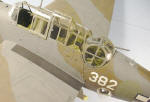 The late-version 5-inch HVARs provided in the kit are accurate only
for the TBM-3 version - most Navy TBF/M-1s that carried rockets used
weapons that looked like the British RPs, fired from rails rather than
zero-length launchers.
The late-version 5-inch HVARs provided in the kit are accurate only
for the TBM-3 version - most Navy TBF/M-1s that carried rockets used
weapons that looked like the British RPs, fired from rails rather than
zero-length launchers.
There are a lot of parts, and opening the box is daunting as one wonders
whether they have the stamina, attention span and focus to go the distance
in finishing the project. This has proven to be the most complex and
complicated out-of-the-box kit build I have done, but it is not d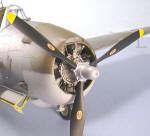 ifficult.
One need only follow the instructions in the very good instruction booklet
in order to proceed with a logical assembly sequence.
ifficult.
One need only follow the instructions in the very good instruction booklet
in order to proceed with a logical assembly sequence.
The kit is very complete, and even provides acceptable photo-etch seat belts (though I preferred to use Cutting Edge posable resin belts on mine). The decals for #95 of VT-2 aboard the USS “Hornet” during the Central Pacific Campaign of 1944 are for one of the more memorably-marked Avengers, and are of very good quality. Out of the box, one can make an Avenger that is thoroughly representative of this great airplane, without any aftermarket items really needed.
| CONSTRUCTION |
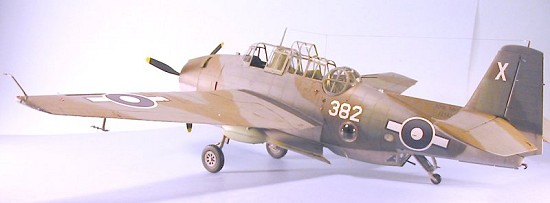 It was obvious that the major area of work was going to be the fuselage, so
the first thing I did was assemble the wings and tail surfaces. I elected
to spread the wings, so I put additional bits of Evergreen sheet wherever
possible along the wingfold from inside, to strengthen that joint. I also
attached the ailerons and flaps to their respective wing halves before
further assembly of the wings. I opted to close the flaps because there
were a large number or mold-release pins to clean up on the inside of the
flaps, that I didn’t want to deal with. Also, Avengers do not normally sit
on the ground with their flaps down.
It was obvious that the major area of work was going to be the fuselage, so
the first thing I did was assemble the wings and tail surfaces. I elected
to spread the wings, so I put additional bits of Evergreen sheet wherever
possible along the wingfold from inside, to strengthen that joint. I also
attached the ailerons and flaps to their respective wing halves before
further assembly of the wings. I opted to close the flaps because there
were a large number or mold-release pins to clean up on the inside of the
flaps, that I didn’t want to deal with. Also, Avengers do not normally sit
on the ground with their flaps down.
I had discovered going through the decal dungeon that I could piece together markings to do an Avenger of the British Pacific Fleet, and I also had extra vacuform “bubbles” from the Falcon B-29 set that were the right size for the observer’s blisters on British Avengers. Thus, I could follow my usual path of not being one of the crowd, by doing an Avenger I or II. All that would be needed was modifying the second cockpit with a seat. I used a seat from a Trumpeter P-38, since I had replaced that cockpit with a Rutman conversion. All that was further necessary was to use some Evergreen sheet to make the stringers along the left cockpit wall where the “black boxes” of the American Avenger wouldn’t be used.
 The first big deal was to do some interior painting, and this involved
deciding whether I was going to do an Avenger I or an Avenger II. The
Grumman-built Avenger I had the first and second cockpits in Bronze Green,
with the radioman’s compartment, the turret, and the bomb bay in Interior
Green, with the cowling interior in light grey. An Eastern Aircraft-built
Avenger II would have the cockpit, turret and radio compartment in overall
Interior Green, with the bomb bay and cowling interior in Zinc Chromate. I
decided on an Avenger II mostly because the exterior would also be
different, since it would be in “equivalent colors” instead of the standard
FAA colors.
The first big deal was to do some interior painting, and this involved
deciding whether I was going to do an Avenger I or an Avenger II. The
Grumman-built Avenger I had the first and second cockpits in Bronze Green,
with the radioman’s compartment, the turret, and the bomb bay in Interior
Green, with the cowling interior in light grey. An Eastern Aircraft-built
Avenger II would have the cockpit, turret and radio compartment in overall
Interior Green, with the bomb bay and cowling interior in Zinc Chromate. I
decided on an Avenger II mostly because the exterior would also be
different, since it would be in “equivalent colors” instead of the standard
FAA colors.
 Gunze-Sangyo “Interior Green” and Tamiya “Chromate Green” were used, with
the instrument panel and other “black boxes” done with Tamiya “Semi-Gloss
Black.” I also used Tamiya “Smoke” to “pop out” the interior detail, later
painting everything with Testor’s Dullcote to get rid of the glossy sheen.
Gunze-Sangyo “Interior Green” and Tamiya “Chromate Green” were used, with
the instrument panel and other “black boxes” done with Tamiya “Semi-Gloss
Black.” I also used Tamiya “Smoke” to “pop out” the interior detail, later
painting everything with Testor’s Dullcote to get rid of the glossy sheen.
I used Cutting Edge posable resin US seat belts for both pilot’s and second cockpit, since research showed that Eastern did not use the Sutton Harness on their Avenger IIs, and the FAA did not replace these US seatbelts with British items in all cases (that and the fact I had the US seatbelts and didn’t have the Sutton sets - it’s amazing what rationalizing can accomplish).
Like I said, there are a lot of parts involved. The good news is, they all fit. They are merely time-consuming to find on the myriad of sprues, and to attach, but there is no “extra effort” required in assembly.
 The turret is practically a model in itself. Due to the fact that you
cannot squeeze this into the fuselage after closing up the halves, you need
to fully paint the turret before placing it in position, and then you will
need to mask it off to protect it once you start painting the exterior.
While some Avengers did fly with the turret open along the slot for the
machine gun in order to provide some “air conditioning” for the gunner in
the tropics, most used a set of zippers, similar to other US turrets, to
close off the turret from the weather outside. I filled in the slot with
white glue, then painted it Olive Drab, to simulate the zipper system.
The turret is practically a model in itself. Due to the fact that you
cannot squeeze this into the fuselage after closing up the halves, you need
to fully paint the turret before placing it in position, and then you will
need to mask it off to protect it once you start painting the exterior.
While some Avengers did fly with the turret open along the slot for the
machine gun in order to provide some “air conditioning” for the gunner in
the tropics, most used a set of zippers, similar to other US turrets, to
close off the turret from the weather outside. I filled in the slot with
white glue, then painted it Olive Drab, to simulate the zipper system.
 The R-2600 is another “model in its own right” and is as fully detailed as
the R-2800s provided in the Trumpeter Corsair kits. I fully painted mine
to show you what is there, but the sad truth is that once you install the
cowling, you can only see the front of the engine. That said, what is
provided could be the basis for a very good-looking fully-detailed engine
compartment for those who want to open the cowling to display what’s
inside.
The R-2600 is another “model in its own right” and is as fully detailed as
the R-2800s provided in the Trumpeter Corsair kits. I fully painted mine
to show you what is there, but the sad truth is that once you install the
cowling, you can only see the front of the engine. That said, what is
provided could be the basis for a very good-looking fully-detailed engine
compartment for those who want to open the cowling to display what’s
inside.
 Once everything was painted and installed inside the fuselage, I glued the
halves together. I needed to take my time here, to get everything properly
squeezed into its correct position, but when that was done there was no
problem gluing it together and the resultant centerline seam was very small
and required only a very little bit of Mr. Surfacer 500 to make it
disappear. I also used Mr. Surfacer on the leading edge seams of the
wings. Given the size of the model, I wrapped it with rubber bands to
get
Once everything was painted and installed inside the fuselage, I glued the
halves together. I needed to take my time here, to get everything properly
squeezed into its correct position, but when that was done there was no
problem gluing it together and the resultant centerline seam was very small
and required only a very little bit of Mr. Surfacer 500 to make it
disappear. I also used Mr. Surfacer on the leading edge seams of the
wings. Given the size of the model, I wrapped it with rubber bands to
get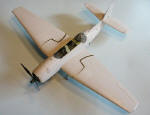 everything to set up right before proceeding with further assembly.
everything to set up right before proceeding with further assembly.
Attaching the wings was easy, and the resultant joint is strong due to the spar bracing in the kit design. With the wings and horizontal stabilizers attached, it as time to move on to painting once all had set up.
I installed the landing gear legs at this point so the model would have something to sit on while being painted.
| COLORS & MARKINGS |
Painting:
Perhaps one of the most tedious processes of the entire project was masking off the large greenhouse canopy and the gun turret. The turret had been masked and painted before being inserted in the fuselage, and was covered with drafting tape for this part of the process.
Since Grumman had dealt with the Fleet Air Arm prior to the advent of
Lend-Lease for the sales of early Martlet fighters, Grumman-built Avenger
Is used Dupont paints mixed to Fleet Air Arm standards, so that they were
camouflaged in Dark Sea 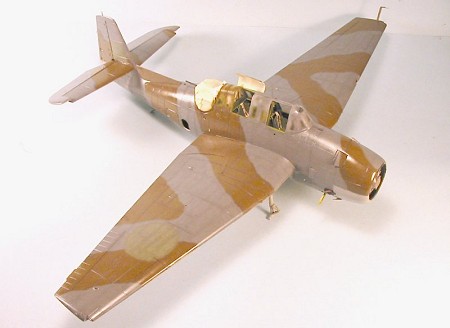 Grey, Slate Grey and Sky. The Eastern Aircraft
Avenger IIs used U.S. “equivalent colors” for their camouflage. Sea Grey
was substituted for Dark Sea Grey, Olive Drab for Slate Grey, and Sky Grey
for Sky. Additionally, Grumman-built Avenger Is had a “hard edge” color
demarcation, while Eastern Aircraft Avenger IIs had a more “soft-edge”
color demarcation.
Grey, Slate Grey and Sky. The Eastern Aircraft
Avenger IIs used U.S. “equivalent colors” for their camouflage. Sea Grey
was substituted for Dark Sea Grey, Olive Drab for Slate Grey, and Sky Grey
for Sky. Additionally, Grumman-built Avenger Is had a “hard edge” color
demarcation, while Eastern Aircraft Avenger IIs had a more “soft-edge”
color demarcation.
After “pre-shading” the model, I used Tamiya “Sky Grey” for the lower surfaces and Tamiya “Dark Grey”, lightened with Tamiya “Sky Grey” for the upper surface Grey. I used Tamiya “NATO Khaki” as the base for the Olive Drab color, which I then went over with Gunze-Sangyo “Olive Drab 2" to get the multi-hue faded look.
I wanted to end up with a model of an airplane that had spent a lot of time in the tropics, since 848 Squadron had first gone to Ceylon in the fall of 1944 where they operated on antisubmarine patrol from escort carriers in the Indian Ocean, and had then gone aboard HMS Formidable in Australia when the British Pacific Fleet returned in June from “Operation Iceberg,” the invasion of Okinawa. These airplanes had originally come from the factory with the standard British national insignia, which was later overpainted as they moved to Ceylon where they flew with the FAA’s version of SEAC insignia, which had then been overpainted when the BPF insignia was applied. Reasoning this would have been done by FAA crews with FAA paints, I overpainted the areas of the upper wing roundel on the right wing, the fuselage roundel positions, and the area of the vertical fin where the fin flash would have been with FAA Slate Grey, which I then “faded” by adding some white and going over the area to get different shades. I decided the drop tanks would have been standard ones made by Grumman, and thus painted in Sky.
Markings:
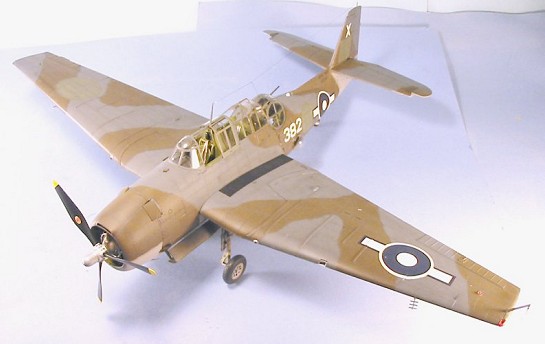 I
had information that would allow me to do an Avenger II from 848 Squadron
aboard HMS Formidable for the strikes against the Japanese home islands in
the last six weeks of the war. 848 operated both Avenger I and Avenger II
aircraft, as did many FAA Avenger squadrons.
I
had information that would allow me to do an Avenger II from 848 Squadron
aboard HMS Formidable for the strikes against the Japanese home islands in
the last six weeks of the war. 848 operated both Avenger I and Avenger II
aircraft, as did many FAA Avenger squadrons.
There was no “standard size” to the British Pacific Fleet insignia - roundel sizes were generally based on what the roundel size had been painted on the airplane when it was first assigned to the Far Eastern Fleet and carried SEAC insignia, which was supposed to be smaller than standard British insignia. Some aircraft, like the Corsair, had large insignia like their US Navy kin, while some Hellcats had much smaller insignia. Avengers seem to have varied from plane to plane within a unit. I based mine on “educated guessing” after looking at pictures of British Avengers in various publications.
I used the fuselage insignia from the kit decal sheet as the basis for the wing insignia, then cut a white circle from a decal sheet of white decal. I used the white center roundels from the old Classic Airframes Blenheim V decal sheet, since they were the right size, with the bars from the American marking finishing off. The fuselage insignia came from an Aeromaster sheet for the Corsair II, which was exactly the right size for this Avenger based on a photo. The fleet number and Carrier identification letter came from an Aeromaster number sheet in 1/48 for 30" high numbers in that scale. The Royal Navy and the serial number came from an ancient Modeldecal sheet found deep in the decal dungeon (never ever throw away anything!) and pieced together to get a serial for an Easter Aircraft-built Avenger II. The stencil decals came from the Trumpeter sheet.
| FINAL CONSTRUCTION |
I gave the model two coats of Testor’s Dullcote to get a thoroughly-flat finish as an airplane based in the tropics in a marine environment would have after seven or eight months of operation. After that, I gave the model some exhaust stains with Tamiya “Smoke.”
The kit wheels were assembled and attached. I don’t like the rubber
wheels Trumpeter uses, but have heard they do not melt the hubs the way
these kinds of wheels have done in Hobbycraft and AMT kits. If I get
the chance to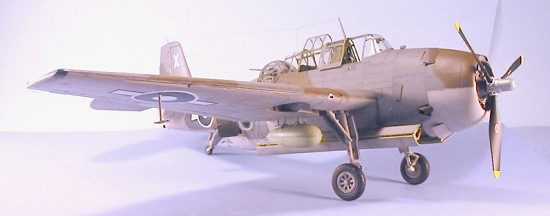 use some
resin wheels I will.
use some
resin wheels I will.
The large greenhouse canopy was unmasked and the sliding portions were placed in open position. I discovered that the upper folding portion of the second cockpit canopy had been molded cocked over too far to the left, so I scored the base with my craft knife and bent it to the right into position so that the sliding portion would be in the proper position at the top of its rails. I then attached the vacuform observer bubbles with white glue.
I also scratchbuilt and attached a K-14 gunsight in the pilot’s cockpit, since the kit does not provide a gunsight.
The bomb-bay doors went together with their photo-etch interior more easily than expected and fit to the hinges without difficulty.
I attached all the various light covers and installed the propeller. The antenna wires were made from nylon repair thread.
| CONCLUSIONS |
This Avenger is the most accurate kit Trumpeter has released of a non-Soviet subject. The kit makes up into an accurate and attractive model that will be bound to impress when your friends see it sitting on the shelf. (And as to how much space it will take on said shelf: the Avenger is close in fuselage length and wingspan to the P-38.)
Editorializing here, I hope that some well-known (or even not so well-known) aftermarket parts maker is already involved in designing and producing conversion sets to do the TBF-1C kit as a TBF-1 and as a TBM-1/3D, and a Fleet Air Arm Avenger I/II with the second cockpit parts, and to correct the prop for the TBM-3 and do a conversion for the TBM-3E, because these should all be easy. Such an aftermarket designer could even go further with the TBM-3 kit, doing conversions for the TBM-3W and TBM-3S, and the Avenger AS.4. While you certainly don’t need any of these to come up with a good looking model right out of the box (other than a prop if you’re doing a TBM-3, and you could use the old Hasegawa Hellcat prop for that), once you’ve done one of these, you may find yourself thinking (as I am already) about the possibility of doing other versions of this really nice model.
To my mind, the Trumpeter Avenger is a perfect example of why 1/32 scale models are supposed to exist - it’s impressively large and extremely well-detailed. Buy it in confidence and build it with pleasure.
February 2005
Copyright ModelingMadness.com
If you would like your product reviewed fairly and fairly quickly, please contact the editor or see other details in the Note to Contributors.